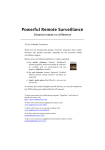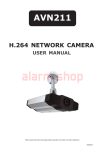Download Manual English
Transcript
OUTDOOR IR NETWORK CAMERA Series User Manual Please read instructions thoroughly before operation and retain it for future reference. IMPORTANT SAFEGUARD All lead-free products offered by the company comply with the requirements of the European law on the Restriction of Hazardous Substances (RoHS) directive, which means our manufacture processes and products are strictly “lead-free” and without the hazardous substances cited in the directive. The crossed-out wheeled bin mark symbolizes that within the European Union the product must be collected separately at the product end-of-life. This applies to your product and any peripherals marked with this symbol. Do not dispose of these products as unsorted municipal waste. Contact your local dealer for procedures for recycling this equipment. Disclaimer We reserve the right to revise or remove any content in this manual at any time. We do not warrant or assume any legal liability or responsibility for the accuracy, completeness, or usefulness of this manual. The content of this manual is subject to change without notice. Grounding This is a Safety Class 1 Product (provided with a protective earthing ground incorporated in the power cord). The mains plug shall only be inserted in a socket outlet provided with a protective earth contact. Any interruption of the protective conductor inside or outside of the instrument is likely to make the instrument dangerous. Intentional interruption is prohibited. Water & Moisture Do not expose this product to dripping or splashing and that no objects filled with liquids, such as vases, shall be placed on the product. Trademark Acknowledgements iPhone® is the registered trademark of Apple Inc. BlackBerry® and related trademarks, names and logos are the property of Research In Motion Limited and are registered and/or used in the U.S. and countries around the world. Used under license from Research In Motion Limited. Android™ is a trademark of Google Inc. Use of this trademark is subject to Google Permissions. Microsoft, Windows, Internet Explorer, Mozilla Firefox, Google Chrome, QuickTime, Windows Mobile & Symbian mentioned in this document are the registered trademarks of their respective holders. MPEG4 Licensing THIS PRODUCT IS LICENSED UNDER THE MPEG4 VISUAL PATENT PORTFOLIO LICENSE FOR THE PERSONAL AND NON-COMMERCIAL USE OF A CONSUMER FOR (i) ENCODING VIDEO IN COMPLIANCE WITH THE MPEG4 VISUAL STANDARD (“MPEG-4 VIDEO”) AND/OR (ii) DECODING MPEG4 VIDEO THAT WAS ENCODED BY A CONSUMER ENGAGED IN A PERSONAL AND NON-COMMERCIAL ACTIVITY AND/OR WAS OBTAINED FROM A VIDEO PROVIDER LICENSED BY MPEG LA TO PROVIDE MPEG4 VIDEO. NO LICENSE IS GRANTED OR SHALL BE IMPLIED FOR ANY OTHER USE. ADDITIONAL INFORMATION INCLUDING THAT RELATING TO PROMOTIONAL INTERNAL AND COMMERCIAL USES AND LICENSING MAY BE OBTAINED FROM MPEG LA, LLC. SEE HTTP://WWW.MPEGLA.COM. GPL Licensing This product contains codes which are developed by Third-Party-Companies and which are subject to the GNU General Public License (“GPL”) or the GNU Lesser Public License (“LGPL”). The GPL Code used in this product is released without warranty and is subject to the copyright of the corresponding author. Further source codes which are subject to the GPL-licenses are available upon request. We are pleased to provide our modifications to the Linux Kernel, as well as a few new commands, and some tools to get you into the code. The codes are provided on the FTP site, and please download them from the following site or you can refer to your distributor: http://download.dvrtw.com.tw/GPL/076D_Series/arm-linux-2.6.tar.gz TABLE OF CONTENTS 1. OVERVIEW ............................................................................................................................................ 1 1.1 Product features .......................................................................................................................................... 1 1.2 Package content .......................................................................................................................................... 1 1.3 Dimensions .................................................................................................................................................. 1 1.4 Cable overview ............................................................................................................................................ 1 2. BEFORE USING YOUR NETWORK CAMERA .................................................................................... 2 3. ACCESSING THE CAMERA VIA VIDEO VIEWER ............................................................................... 3 3.1 Installing Video Viewer ................................................................................................................................ 3 3.2 Accessing the camera.................................................................................................................................. 3 3.3 Control panel overview ................................................................................................................................ 4 3.3.1 Simplified version (Default) ........................................................................................................................... 4 3.3.2 Full function version ...................................................................................................................................... 5 3.3.3 Main button overview .................................................................................................................................... 5 3.4 Frequently-used functions ........................................................................................................................... 6 3.4.1 Record .......................................................................................................................................................... 6 3.4.2 Playback ....................................................................................................................................................... 6 3.4.3 Firmware upgrade ......................................................................................................................................... 7 3.4.4 E-Map ........................................................................................................................................................... 7 4. CAMERA CONFIGURATIONS VIA WEB BROWSER ........................................................................ 12 4.1 Accessing the camera................................................................................................................................ 12 4.2 Control panel overview .............................................................................................................................. 13 4.3 System configuration menu ....................................................................................................................... 14 4.4 Network ...................................................................................................................................................... 15 4.4.1 Network ....................................................................................................................................................... 15 4.4.2 QoS............................................................................................................................................................. 15 4.4.3 DDNS .......................................................................................................................................................... 15 4.4.4 SNTP .......................................................................................................................................................... 15 4.4.5 FTP ............................................................................................................................................................. 16 4.4.6 Mail ............................................................................................................................................................. 16 4.4.7 SMS ............................................................................................................................................................ 16 4.4.8 Filter ............................................................................................................................................................ 17 4.4.9 UPnP / Bonjour ........................................................................................................................................... 18 4.5 Camera ...................................................................................................................................................... 19 4.5.1 System ........................................................................................................................................................ 19 4.5.2 Color ........................................................................................................................................................... 19 4.5.3 Time ............................................................................................................................................................ 20 4.5.4 Advance ...................................................................................................................................................... 20 4.6 General ...................................................................................................................................................... 21 4.6.1 General ....................................................................................................................................................... 21 4.6.2 Server Log .................................................................................................................................................. 21 4.6.3 Online ......................................................................................................................................................... 22 4.6.4 Account ....................................................................................................................................................... 22 4.6.5 Trigger ......................................................................................................................................................... 23 4.6.6 Video ........................................................................................................................................................... 24 4.6.7 Google Maps............................................................................................................................................... 24 4.6.8 Upgrade ...................................................................................................................................................... 25 APPENDIX 1 PRODUCT SPECIFICATIONS .......................................................................................... 26 APPENDIX 2 API ID APPLICATION FOR SMS MESSAGING ............................................................... 27 APPENDIX 3 BIT RATE TABLE FOR REFERENCE .............................................................................. 29 1. OVERVIEW 1.1 Product features Powerful Remote Surveillance on Multiple Mobile Platforms -- For mobile device platforms, iPad®, iPod®, iPhone®, BlackBerry®, Nokia® Symbian, Windows® Mobile & Android™ (with their built-in web browsers or EagleEyes) -- For web browsers, Internet Explorer®, Mozilla Firefox®, Safari®, Google Chrome™ and Opera -- For operating systems, Windows & Mac -- For multiple device control, our CMS software, Video Viewer, is provided for free Smart Zoom: zoom in on the object that triggered the event The best cost / performance outdoor solution with IP67 IR effective distance up to 40 meters with 56 IR LEDs Smart Light Control to avoid overexposure Excellent outdoor ID design with cable management Low-latency video streaming with H.264 compression format Free CMS software with E-Map for multiple devices control & surveillance Motion detection and event notification functions (AVN263V Only) ONVIF standard supported to simplify system integration 1.2 Package content □ □ □ □ Network camera □ Installation Sticker Installation Guide □ RJ45 cable extender adapter Ground Wire CD-ROM disc (including user manuals & CMS software “Video Viewer”) 1.3 Dimensions 117.89 287.4 212.63 246.87 241.03 1.4 Cable overview 1 CABLE DESCRIPTION RJ45 network cable Connect it to the supplied RJ45 cable extender adapter for cable extension, and prepare another RJ45 network cable with suitable length for your connection. Reset wires Remove the insulating coating of these two wires, and twist them together to reset default. This will reset all parameters, including the IP address to factory default settings. Note: Disconnect power before twisting these two wires together, and connect to power again for reset default. When the reset is done, disconnect these two wires. Power wires Connect to AC power supply. For details, please refer to the installation guide. 1 2. BEFORE USING YOUR NETWORK CAMERA This network camera can be accessed via our supplied CMS software “Video Viewer”, the web browser (such as “Microsoft Internet Explorer” or “Mozilla Firefox”), and smart phones with our self-developed program “EagleEyes” installed depending on different using situations. Note: For details about accessing network cameras via smart phones, please refer to http://www.eagleeyescctv.com. Before using the network camera, make sure: 1) You have installed the supplied CMS software, “Video Viewer”, or a web browser. 2) You have configured the network settings, and the network connection is fine. For Video Viewer installation, please refer to “3.1 Installing Video Viewer” at page 3. For network configurations, please refer to your installation guide. To check or configure up to 16 surveillance devices simultaneously with the record function, please use “Video Viewer”. For details about using Video Viewer, please refer to “3. ACCESSING THE CAMERA VIA VIDEO VIEWER” at page 3, and “4. CAMERA CONFIGURATION” at page 12. To check or configure this network camera only, it’s recommended to use a web browser, such as “Microsoft Internet Explorer” or “Mozilla Firefox”. For details about using the web browser, please refer to “4. CAMERA CONFIGURATIONS VIA WEB BROWSER” at page 12. 2 3. ACCESSING THE CAMERA VIA VIDEO VIEWER 3.1 Installing Video Viewer Step1: Place the supplied CD into your CD-ROM or DVD-ROM drive. The program will be automatically run. Step2: Click “Program” in the “Video Viewer” section to install Video Viewer, or click “Download The Latest Version” under “Program” to download the latest version of Video Viewer from the Internet (if your PC is connected to Internet). Step3: Follow the on-screen instructions to finish the installation. When the installation is completed, a shortcut icon “ ” will be placed on your PC desktop. 3.2 Accessing the camera Step1: Double-click “ ” on your PC desktop to open Video Viewer. By defaults, the “Address Book” panel will be displayed on the right side of the control panel. Step2: In “Address Book”, click “ ” to key in the IP address, user name, password, and port number of the camera you intend to connect. OR Click “ ” “ ” to search the available IP address(es) of other camera(s) under the same domain as your PC’s IP address. The found address(es) will be listed, and can be added into the address book by clicking “ ”. Step3: Double-click the IP address you just added into the address book to log in. The live view is displayed in the Video Viewer. 3 3.3 Control panel overview Two control panels are available and can be switched depending on your using habit. 3.3.1 Simplified version (Default) 4 3.3.2 Full function version 3.3.3 Main button overview Button Simplified Full Function Function Address Book Description Click to show the predefined IP address(es). You can add, remove or search the IP address to log in the DVR remotely. Miscellaneous Remote Config Click to go to the detailed system configuration. Record Setting Click to go to the detailed record setting. For details, please refer to “3.4.1 Record” at page 6. Custom Setting Click to choose the language of this program, or set the password when activating this program. The changes will take effect when this program is closed and executed again. Control Log Click to view all event and recording logs, search the desired log(s) by date, or playback the recording of the selected log. Click to start / stop the manual recording. / / Record / Record Stop Snapshot The record button will be disabled when the reserved disk capacity set in “Record Setting” is larger than the current disk capacity. For details, please refer to “3.4.1 Record” at page 6. Click to take a snapshot of the current view. The snapshot will be saved in the path you specified in “Record Setting”. Information Click to show the current network connection details. PTZ Control Click to enter the PTZ control panel for the smart zoom function. 5 3.4 Frequently-used functions 3.4.1 Record To record remotely, click “ ” or “ ” → “ ” to go to the “Record Setting” page. In the “Record Setting” page, you can set the following items: ‧Record type ‧Pre- / post-event record time (0~10 seconds) ‧Record time setting ‧Record path Note: The record function will be disabled when the reserved disk capacity in “Reserved(MB)” is larger than the current disk capacity in “Free(MB)”. When “Manual” is checked, click “ ” or “ ” on the main control panel to start the manual recording immediately, and the recordings will be saved in the location specified in “Record Path”. When “Motion” and / or “Alarm” are checked, the recording function will be enabled for any motion or alarm event, and the recordings will be saved in the location specified in “Record Path”. 3.4.2 Playback To play a recording, click “ ” or “ ”, and select the “Record” tab. A list of all the recordings will be shown by defaults, and you can also sort out the logs you want to speed up the search time. 6 3.4.3 Firmware upgrade This function is used when users need to upgrade the network camera for function scalability. Note: Before using this function, make sure you have the correct upgrade files provided by your installer or distributor. Step1: Click “ Step2: Click “ ”, and select the IP address of your network camera in the address book. ” to show the upgrade page, “Update Server”. Step3: Click “Add” to browse to the upgrade files. Step4: Click “Upgrade Firmware” to start firmware upgrade. Note: It takes a few minutes to finish the upgrade process. Do not disconnect the power during firmware upgrade, or the upgrade may be failed. The camera will reboot after the upgrade. Step5: Select the IP address of the camera and click “ ” again to check if the firmware is upgraded. 3.4.4 E-Map Video Viewer is also a Central Management System (CMS) software, which allows network device control & management for up to 16 devices simultaneously. Note: Before using this function, make sure Video Viewer is connected to all the devices (up to 16) you want to monitor. E-Map is ONLY available when the control panel is switch to the full function version. How to add an E-Map group STEP1: In the simplified version, click “ ” to switch the control panel to the full function version, and click “ ” to enter the E-Map page as follows. Note: To know where the buttons are, please refer to “3.3.1 Simplified version (Default) at page 4, and “3.3.2 Full function version” at page 5. 7 STEP2: Right-click to show the shortcut menu on the top-left panel, and select the E-Map group you want to add. There are three E-Map groups you can add: Google E-MAP, Single E-MAP, and Building E-MAP. 8 STEP3: When the E-Map group is created, you will see the tree on the top-left panel, showing all the devices you’ve added to this group. Icon Description The connected device is camera. When it’s selected, it will become red. The connected device is DVR. When it’s selected, it will become red. For any motion or alarm event, it will appear on the screen to catch your attention. To know what’s happening quickly, double-click the device icon on the E-Map to show the live view. 9 How to edit / remove an existing E-Map group For Google E-Map Group Right-click on the group name to show the shortcut menu list, and select “Edit E-MAP” or “Remove E-MAP” as needed. You can also add a single E-Map group (Add Single E-MAP) or Building E-Map group (Add Building E-MAP) into the existing Google E-Map group. For Single E-Map Group Right-click on the group name to show the shortcut menu list, and select “Edit E-MAP” or “Remove E-MAP” as needed. 10 For Building E-Map Group Right-click on the group name to show the shortcut menu list, and select “Edit Building E-MAP” or “Remove E-MAP” as needed. 11 4. CAMERA CONFIGURATIONS VIA WEB BROWSER Users can also access the network camera via a web browser, such as Microsoft Internet Explorer, Mozilla Firefox, Google Chrome or Safari. Note: It’s recommended to consult with your installer before changing system configurations. Note: You need to be the supervisor to enter the system configuration page. If not, please re-log into the camera with the supervisor user level. However, the web browser is only available for single device access. If users want to access more than two devices through one interface, it’s recommended to use our supplied CMS software, Video Viewer. For details, please refer to “3. ACCESSING THE CAMERA VIA VIDEO VIEWER” at page 3. Before using the network camera, make sure you have configured the network settings and have the IP address, user name and password used for accessing the camera in hand. If not, please refer to the installation guide. 4.1 Accessing the camera Step1: Open your web browser, and key in http://ipaddress:portnum in the URL address box. For example, for IP address 60.121.46.236 and port No. 888, please key in ”http://60.121.46.236:888” into the URL address box, and press “Enter”. Step2: In the login page, key in the user name and password, and enter the security code from the image below if any. Then, click “LOGIN”. Step3: The wizard is then started. ‧ To skip the wizard and directly access the camera live view, click “Close”. ‧ To directly access the camera live view without starting the wizard for the login next time, check “Do not start wizard at login”. Step4: When the login is successful, the live view is shown. 12 4.2 Control panel overview Function Icon Media Type -- User Level Description Supervisor / Power User / Normal User / Guest Select the web transmission format from the drop-down list: H.264 / MPEG-4 / Motion JPEG / QuickTime For users using Mozilla Firefox, only “QuickTime” is selectable. QuickTime is Apple Inc.’s multimedia software. You need to have QuickTime installed in you operating system before selecting “QuickTime”. When it is selected, you will be promoted to enter the user name and password to access the camera. Video Quality -- Supervisor / Power User / Normal User Click & drag the slider to select the video quality: Basic / Normal / High / Best. Supervisor / Power User / Normal User Select the video resolution from the drop list: 4CIF / CIF. Snapshot Supervisor / Power User / Normal User Click to take a snapshot for the current view, and a new browser window will be opened to display the captured image. Full Screen Supervisor / Power User / Normal User Click to display the image in full screen. Flip Supervisor / Power User / Normal User Click to rotate the image 1800 counterclockwise when necessary. Video Resolution Zoom-in / out / Supervisor / Power User / Normal User Click to zoom in / out the current image. Max. Zoom-in / out / Supervisor / Power User / Normal User Click to zoom in the image to the largest / zoom out the image to its original size. Smart Zoom Supervisor / Power User / Normal User Click to activate the smart zoom function. Smart Zoom 10 Supervisor / Power User / Normal User Touch to enable consecutive Smart Zoom for 10 minutes and disable the idle mode. Consecutive Smart Zoom will be off after 10 minutes, and auto Smart Zoom will be on instead. 13 4.3 System configuration menu Click “Configuration” to enter the configuration page. Note: You need to be the supervisor to enter the system configuration page. If not, please re-log into the camera with the supervisor user level. The functions are categorized into three menus: Network, Camera and General. For details about “Network”, please refer to “4.4 Network” at page 15. For details about “Camera”, please refer to “4.5 Camera” at page 19. For details about “General”, please refer to “4.6 General” at page 21. Main Menu Sub-Menu Reference Network Network Configure network settings. QoS Limit the data flow for live streaming. DDNS Enter DDNS information when the network type is PPPOE or DHCP. SNTP Synchronize your camera time with the networked computer systems. FTP Enter the FTP information for event notifications when “FTP” is chosen in “General” → “Trigger”. Mail Enter Email information for event notifications when “Email” is chosen in “General” → “Trigger”. SMS Enter text messaging information for SMS notifications when “SMS” is chosen in “General” → “Trigger”. Filter Choose to permit or block the IP address(es) which can access this camera. *Suitable for Windows-based operating system. UPnP Allow this camera to be detected among devices within the same network area for easy and quick usage. *Suitable for Apple Mac-based operating system. Camera General Bonjour Allow this camera to be detected among devices within the same network area for easy and quick usage. System Set the camera OSD display. Color Adjust the color performance. Time Set daylight saving time and the current time. Advance Adjust the camera parameters if necessary. General 1. Select the language of the web browser. 2. Check the MAC address of the camera. Server Log Check the system event logs. Online 1. Check current online user(s). 2. Set anonymous login 3. Set image code verification at login Account 1. Create a new user account with different access privilege. 2. Modify or delete an existing user account. Trigger 1. Enable / disable the motion detection. 2. Set the motion detection area. 3. Select the event notification method. Video Select video file size and image quality. Google Maps Allow you to know where the network camera is. Upgrade Check the current firmware version and upgrade. 14 4.4 Network 4.4.1 Network You can set the network configuration of the network camera depending on your network type. For details, please refer to your installation guide. 4.4.2 QoS QoS, Quality of Service, is the ability to control the data flow for real-time streaming. This function is important if your network bandwidth is insufficient and you have other devices to share the network bandwidth. Check “QoS Enable”, and set the max. upload rate from 256 to 10240 kbps. 4.4.3 DDNS Select “On” when the selected network type in “Network” is “PPPOE” or “DHCP”. For details, please refer to the installation guide. 4.4.4 SNTP SNTP (Simple Network Time Protocol) is used to synchronize your camera time with the networked computer systems. Function Description GMT Once users choose the time zone, the network camera will adjust the local area time of the system automatically. NTP Server Simply use the default SNTP server (For example, tock.stdtime.gov.tw) or change to another server with which users are familiar. Sync. Period Select “Daily” to synchronize the camera time with the network time every day or 15 Function Description “None” to turn off this function. Server Time Click and the network camera will synchronize the time with the network time. 4.4.5 FTP Enter the detailed FTP information and click “Save” to confirm. The information you set here will be applied when “FTP” is selected in “General” → "Trigger". 4.4.6 Mail Enter the detailed e-mail information and click “Save” to confirm. The information you set here will be applied when “Email” is selected in “General” → "Trigger". Function Description SMTP Server Enter the SMTP server address provided from your e-mail system supplier. Port Enter the port number provided from your e-mail system supplier. If this column is left blank, the e-mail server will use port 25 to send e-mails. Mail From Enter the entire mail address to ensure e-mails will not be blocked by SMTP. SSL Encryption Select “Yes” if your e-mail server is using SSL encryption to protect your e-mail content from unauthorized access. Verify Password Some mail servers are required to verify the password. Please enter the “user name” and “password”. E-Mail Address List Add the e-mail address(s) of the assigned recipient(s). Test When all information is entered, click “Test Mail” to try if the recipe. 4.4.7 SMS Note: Before using this function, you need to apply an API ID from the mobile messaging company, Clickatell, and you will be charged starting from the 11th message. For details, please refer to “APPENDIX 2 API ID APPLICATION FOR SMS MESSAGING’ at page 27. Enter the detailed information needed for text messaging, and click “Save” to confirm. The information you set here will be applied when “SMS” is selected in “General” → "Trigger". 16 Function Description System The text messaging service provider is Clickatell. User name / Password Enter the account user name and password you created in Clickatell. API ID Enter the API ID you applied from Clickatell. Recipient Click “Add” to enter the phone number, including the country code, to receive the text message. Five sets of phone numbers are allowed. Transfer Interval Set the interval time in minutes between two-message sending. The options are 0, 15, 30 & 60. Reset Counter Click to restart the text messaging, and the SMS will be sent after the specified time interval since you click this button. Message Enter the text content (up to 70 characters) you want to send with the text message. Test To know whether your SMS setting is correct, click this button to immediately send a SMS to your phone. Note: This testing is not free and you will be charged for SMS sending base on your local rate. 4.4.8 Filter Choose to permit or block the IP address(es) which can access this camera, and click “Save” to confirm. Function Description Filter Configuration Error Count Set the maximum count for login failure. When the maximum count is reached, the IP address trying to access the network camera will be locked. Error Lock Time Set the lock time in minutes when the maximum count of error login for an IP address is reached. Echo Request Select “Non-Block” to allow other users to use the ping command to detect the IP address of your network camera, or “Block” to deny the ping command request. 17 Function Description IP/MAC Filter Configuration IP/MAC Filter Choose to enable or disable the filter function. IP/MAC Filter Policy If “Enable” is selected, choose whether you want to permit (Allow) or block (Deny) the IP address list below. IP/MAC Filter Rules ‧ ‧ Rule To add an item to the IP address list, key in the IP address in “Rule”, and click “Add”. To remove an existing item in the IP address list, click the item you want to remove, and click “Delete”. 4.4.9 UPnP / Bonjour “UPnP” stands for “Universal Plug and Play”, which allows devices to connect seamlessly in the home and corporate environments and simplify installation of computer components, and is only suitable for Microsoft Windows-based operating system. “Bonjour” functions the same as “UPnP”, but it’s only suitable for Apple Mac-based operating system. UPnP Bonjour Check “Enable” to allow the network camera to be detected among devices within the same network area, and set the identification name of the camera in “Friendly name”. When this function is activated, the other PC within the same domain as this camera will be able to search this camera in: “Network Neighbor” with the identification name set in “Friendly name” for Windows-based PC, or “ ” (finder) or “Bookmark” with the identification name set in “Device Name” for Mac-based PC. Double-click it to quickly open the web browser for camera access. Port Mapping (Available only in UPnP) When your device is connected to Internet via a router and you need to additionally access the router to configure port mapping, this function can eliminate the need to additionally access the router for port forwarding. Note: Before using this function, make sure the UPnP function of your router is also enabled. When “Port Mapping” is set to “Enable”, the system will automatically assign an IP address or port number for you if no IP address or port number is entered. 18 Note: When the configurations are saved successfully, you’ll see a message indicating the IP address and port number assigned to your device. 4.5 Camera 4.5.1 System Set the camera OSD display. Function Description Display Select “CAMERA” to display the camera title you set in “Title” here. Select “SMART ZOOM” to display the current status of Smart Zoom when this function is activated. Select “ALL” to display the camera title and smart zoom status. Select “OFF” to disable this function. Title Enter the title for the camera with up to 15 alphameric characters. Position Set the position where the OSD will be shown: U-L (top-left) / U-R (top-right) / D-L (bottom-left) / D-R (bottom-right). 4.5.2 Color Adjust the color performance from Brightness, Contract, Hue and Saturation. Click and drag the slider to preview the color change on the right side of ths page and adjust the image color. To restore the default values, click “Back to Default”. 19 4.5.3 Time Set daylight saving time and the current time, and click “Save” to confirm. Function Description Time Configuration Date Set the current date. Time Set the current time. Daylight Saving Time Configuration Daylight Saving Time Specify whether to use daylight saving time (Enable / Disable). If this function is enabled, set the time period (Start Time / End Time), and adjust the daylight saving time in hours (Adjust Time). 4.5.4 Advance Adjust the camera parameters if necessary. You can preview the result on the right side of this page. Item Description Back Light It is the function to adjust the image to compensate for an area that is overpowered by brightness because of excessive light. The image will be properly exposed for clearness. Select to activate (ON) or disable (OFF) this function. Note: This function is available only in the day mode. AGC Max It is a function to adjust the amplitude of the signal input according to different light conditions. There are three options available: Low / Middle / High. Mirror Mirror is used when you want to rotate the images horizontally based on your installation situation. The options are: ON / OFF. 20 Item Description Color Mode Color helps to adjust the color level of image through the camera. There are three options available: Color / B/W / Auto. Smart Zoom Select ON to activate / OFF to disable the Smart Zoom function. Before using this function, make sure it’s activated here. Smart Zoom Stand-by Interval Smart Zoom is designed to pause for a certain period of time before the next activation. IR Control Select “AUTO” to automatically enable IR LEDs at night or in the dark environment, or “OFF” to disable this function. Brightness There are three options available: Short / Normal / Long. Brightness helps to adjust the bright level of image based on different light conditions. There are three options available: Dark / Normal / Bright. Sharpness Sharpness enhances the clarity of image detail by adjusting the aperture and sharpening the edges in the pictures. There are three options available: Soft / Normal / Sharp. Color Color helps to set the color level of image through the camera. There are three options available: Light / Normal / Colorful. Smart Zoom Level Sensitivity Here sets the sensitivity of comparing two different images when Smart Zoom is activated. Smart Zoom Temporal Sensitivity Here sets the detection frequency regarding how long one object stays in the detection area and triggers the recording when Smart Zoom is activated. The smaller the value, the more the sensitivity. The larger the value, the more the sensitivity. 4.6 General 4.6.1 General In “General”, you can select the UI language to English or Chinese, and check the MAC address of your camera. To lock camera access when it’s not used after the specified time, select “5 MIN”, “15 MIN” or “30 MIN” from the drop-down list of “Auto Lock Time”, or select “NEVER” to disable this function. 4.6.2 Server Log To quickly search the system logs you want by event type, click “Prev. Page” or “Next Page” to find the logs you want, or check the event type(s) and click “Reload” to start searching. To clear all system event logs, click “Clear All”. 21 4.6.3 Online You can check the current online user(s) with respective online information. To refresh the list, click “Reload”. To allow anonymous login, select “Enable” in “Anonymous Viewer Login”. To disable image code verification at login, select “No” in “Login with CAPTCHA Image”. 4.6.4 Account You can create a new account with different user access privilege, or delete or modify an existing account setting. How to create a new account Step1: Click “New”, and fill in the following columns. Column Description User Name Set a user name that will be used for camera access. The user name allows up to 16 alphanumeric characters. Password Set the password that will be used for remote login. The password allows up to 16 alphanumeric characters. Confirm Password Enter the password again to confirm. User Level Set the security level of an account to give the permission to control different functions. There are four user levels: SUPERVISOR, POWER USER, NORMAL USER and GUEST. Life Time Select how long this account is allowed to stay online (1 MIN / 5 MIN / 10 MIN / 1 HOUR / 1 DAY / INFINITE) Step2: Then, click “Save” to save your setting and create a new account. 22 How to modify or delete an existing account Step1: Select the account you want to modify or delete. Step2: To modify the account, click “Edit” to change the settings, and click “Save”. To remove the account, click “Delete”. Note: It’s not allowed to remove an account when there’s only one account in the account list. 4.6.5 Trigger You can set the motion detection and select the notification function. Trigger Setting In this section, you can select to enable or disable the motion detection. Item Description Motion Select to enable or disable the motion detection function. ‧Motion Detection Area Setting When “Enable” is selected, click “Detection” to enter the motion detection area setting page as follows: Level of Sensitivity: Set the detection sensitivity from 0 ~ 9 (For Model 1 & 2 only), or High / Normal / Low (For Model 3 only). Area Setting: Set the motion detection area by selecting the area grids with your mouse. Pink grids represent the area that is not being detected while the transparent grids are the area under detection. You can set multiple areas under detection. Click “Clear All” to set the whole area undetected. Click “Select All” to set the whole area under detection. Trigger Duration Set the duration time for trigger recording (5 / 10 / 20 / 40 seconds). 23 Notification Setting In this section, you can select to enable e-mail and/or FTP notification when a motion event happens. Item Description Method ‧Email When this option is checked, the network camera will upload the captured video clip to the assigned e-mail address(s) once motion recording happened. ‧FTP When this option is checked, the network camera will upload the captured video clip to the specified FTP site once motion recording happened. ‧SMS When this option is checked, the network camera will send a text message to the specified mobile phone number once motion recording happened. For details, please refer to “4.4.7 SMS” at page 16. Media Type Select the file type of the notification files: H264 (video) / MPEG4 (video) / JPEG (image). Record Time Set the record time of the notification video clip (1 ~ 5 seconds). 4.6.6 Video Set the image resolution, quality and frame rate. Item Description JPEG / MPEG / H264 Select the image resolution and quality. Image Resolution: CIF / 4CIF Image Quality: BEST / HIGH / NORMAL / LOW Frame Rate The frame rate allowed to each viewer can be adjusted to adapt to the bandwidth on the network. Set the desired image frequency to the maximum (FULL) or to a specified frame rate (1/2; 1/3; 1/4; 1/5; 1/10; 1/15; 1/20; 1/25; 1/30). The actual frame rate depends on the actual network connection, and may be lower than the specified one. 4.6.7 Google Maps This function is used to let you know where the network camera is. The system will prompt you to apply a Goole Maps Key if your access is denied. Please follow the instructions below when you’re denied: Step1: Click “Sign up for a Google Maps key” to enter the application page. Step2: Check the terms and conditions, and enter the IP address of the network camera. Then, click “Generate API Key”. Step3: Copy the generated API key, and click “Update Google Maps Key” on the web browser to paste it. 24 4.6.8 Upgrade This function is used when users need to upgrade the network camera for function scalability. Note: Before using this function, make sure you have the correct upgrade files provided by your installer or distributor. Step1: Click “ ” to browse to where you save the upgrade files, and select them one by one until all files are selected (up to four files). Step2: To make a system backup for restore all camera configurations later, click “Backup”. Step3: Click “Upgrade” to start system upgrading. Note: It takes a few minutes to finish the upgrade process. Do not disconnect the power during firmware upgrade, or the upgrade may be failed. The camera will reboot after the upgrade. 25 APPENDIX 1 PRODUCT SPECIFICATIONS AVN263 AVN263V ▓ Network Network Compression H.264 / MPEG4 / MJPEG LAN Port YES LAN Speed Supported Protocols 10/100 Based-T Ethernet DDNS, PPPoE, DHCP, NTP, SNTP, TCP/IP, ICMP, SMTP, FTP, HTTP, RTP, RTSP, RTCP, IPv4, Bonjour, UPnP, DNS, UDP ONVIF Compatible NO Frame Rate NTSC:30, PAL:25 Number of Online Users Security Web management YES 10 Multiple user access levels with password / IP address filtering (1) Web browsers, such as Internet Explorer, Mozilla Firefox, Google Chrome or Safari for single device access, or (2) Free CMS software, Video Viewer, for up to 16 network cameras control simultaneously ▓ Camera Image Sensor Pixels 1/3" HR color CCD image sensor 768(H) x 494(V) <NTSC> / 752(H) x 582(V)) <PAL> Min Illumination 0.05 Lux / F1.8, 0 Lux (IR ON) Shutter Speed 1 / 60 (1/50) to 1 / 100,000 sec. S/N Ratio More than 48dB (AGC off) Lens f4.0mm ~ f9.0mm Viewing Angle 75° ~ 36° IR LED 56 units IR Effective Range Up to 40 meters Smart Light Control YES Smart Zoom YES White Balance ATW AGC Auto IRIS Mode AES IP Rating IP67 Power Source (±10%) AC100V ~ 240V Power Consumption (±10%) Max. 13W Operating Temperature -20℃~40℃ Dimensions (mm)** 287.4(L) x 117.89(W) x 212.63(H) ▓ Others Mobile Surveillance iPad, iPod, iPhone, BlackBerry, Windows Mobile, Symbian & Android Motion Detection YES Event Notification FTP / Email / SMS Minimum Web Browsing Requirements Pentium 4 CPU 1.3 GHz or higher, or equivalent AMD 256 MB RAM AGP graphics card, Direct Draw, 32MB RAM Windows 7, Vista & XP, DirectX 9.0 or later Internet Explorer 7.x or later ** The specifications are subject to change without notice. ** Dimensional tolerance: ± 5mm 26 APPENDIX 2 API ID APPLICATION FOR SMS MESSAGING To allow the camera automatically sending a text message when an event happens, you need to apply an API ID from Clickatell, one mobile messaging company, first. Note: The SMS messaging is not totally free. You will be charged starting from the 11th message. Please follow the steps below for application. Step1: Go to http://www.clickatell.com/login.php. In “New Customers”, select “Clickatell Central (API)” from the drop-down list. Step2: Fill in your information to create an account, and click “CONTINUE”. Note: Note down the user name and password, and the mobile phone number you specified here for SMS notification setting later. Step2: When the account is created, the system will automatically send an Email to your specified Email address and ask you to activate your account. 27 Click the link in the Email to complete account activation, and enter the login page as follows. Enter the password you set, and click “Login”. Step3: Enter the mobile phone number (including your country code) you want the text message to be sent, and click “SEND ACTIVATION CODE”. The system will send an activation code to that number for verification. Check if you receive a text message from Clickatell. Step4: Go back to Clickatell, and click the tab “Manage my Products”. Then, select “HTTP” from the drop-down list “My Connections”. Step5: In “Add HTTP API”, enter a descriptive name for this service, and make sure the dial prefix is correct and callback type is “HTTP GET”. Then, click “Submit”. Step5: You will get an API ID as follows. Note: Note down the API ID for SMS notification setting later. 28 APPENDIX 3 BIT RATE TABLE FOR REFERENCE The data below is for reference only. The bit rates listed here may vary depending on the resolution, image quality & frame rate you choose, the complexity of your monitoring area, and how often the moving objects show in your monitoring area. Testing Environment Place: Office Entrance Network translation: H.264 Static: No one coming in and out Resolution 4CIF CIF 4CIF CIF 4CIF Dynamic: One or two people coming in and out Quality Frame Rate (Dynamic) kbps (Static) kbps Best FULL 2786 1546 High 1375 705 Normal 1234 425 Basic 441 245 Best 955 290 High 364 171 Normal 328 111 Basic 161 68 935 474 High 506 272 Normal 297 175 Basic 223 108 Best 1/5 Best 222 109 High 133 67 Normal 81 49 Basic 71 32 127 70 197 20 Normal 61 11 Basic 50 4 Best 42 7 High 38 2 Normal 22 1 Basic 28 0 Best 1/30 High CIF 29















































